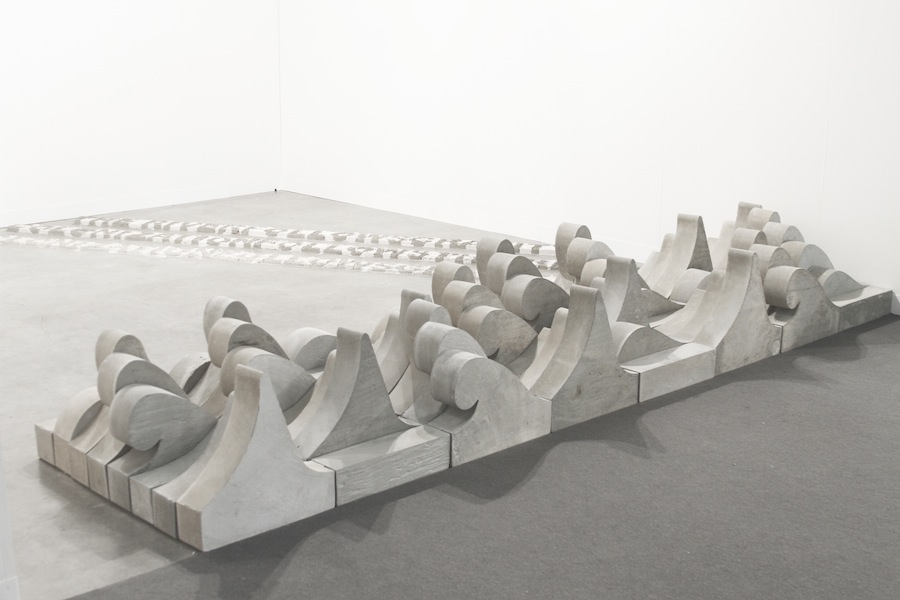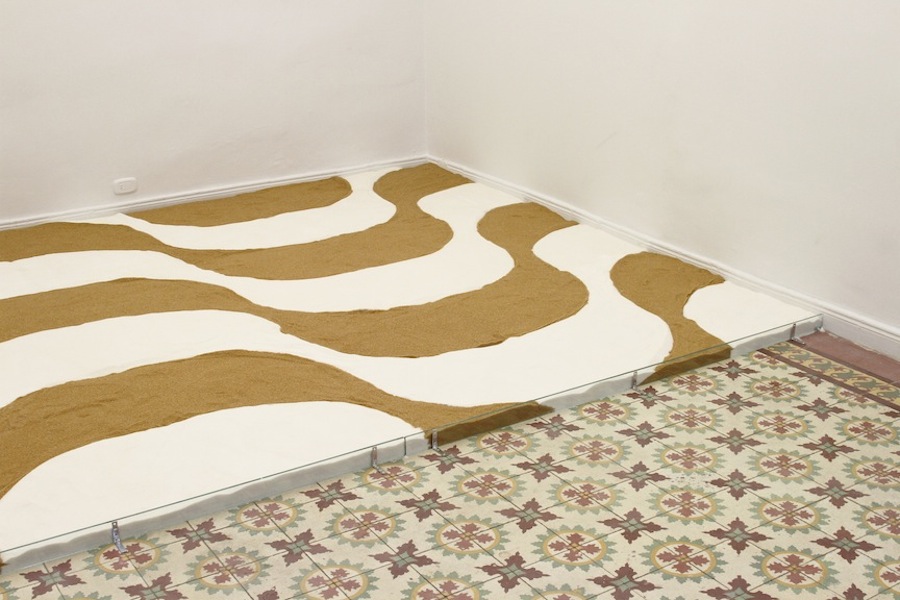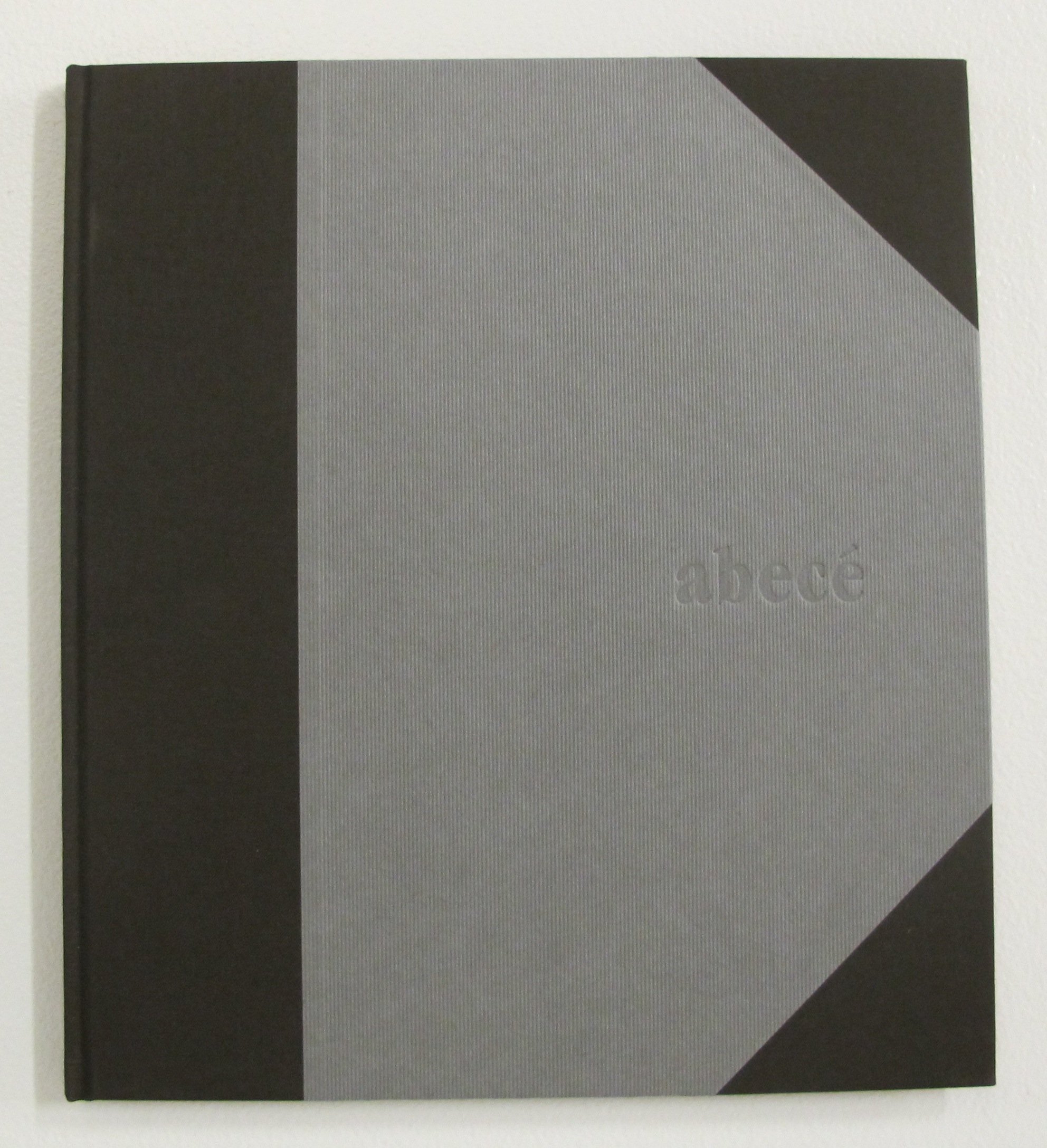
© » KADIST
Mateo Lopez
With Roca Carbón (Charcoal Rock, 2012) and Roca Grafito ( Graphite Rock , 2012), López plays with our relationship to inert and unremarkable objects such as rocks. Traces of art history reverberate through the sculptures; their mediums reflect traditional materials for drawing and sketching, and the simplicity of their forms gesture toward minimalism. But López dislocates these common objects from their ordinary utility by replicating their component parts in paper, graphite, and charcoal, thus drawing attention to mechanisms of representation and translation.

© » KADIST
Mateo Lopez
With Roca Carbon ( Charcoal Rock , 2012) and Roca Grafito ( Graphite Rock , 2012), López plays with our relationship to inert and unremarkable objects such as rocks. Traces of art history reverberate through the sculptures; their mediums reflect traditional materials for drawing and sketching, and the simplicity of their forms gesture toward minimalism. But López dislocates these common objects from their ordinary utility by replicating their component parts in paper, graphite, and charcoal, thus drawing attention to mechanisms of representation and translation.

© » KADIST
Claudia Joskowicz
The primary interest in the trilogy is Joskowicz’s use of cinematic space, with long tracking shots that portray resistance to habitual viewing experiences of film and television. Video plays a role in the relation between the use of her locations and the stories of actual figures depicted as central in the frame. The meaning behind these historical icons such as Che and Cassidy, speak to their stories as itinerant figures whom traveled in a preglobalized era through borders and cultures in order to escape the law or overthrow it.

© » KADIST
Milena Bonilla
Drawing & Print (Drawing & Print)
Milena Bonilla’s discursive practice explores connections among economics, territory, and politics through everyday interventions. Her drawings, sculptures, and photography are active investigations into our often-fallible notions of history. Stone Deaf (2009) is a direct intervention into Karl Marx’s gravesite, for which the artist literally traced the history of Marx’s grave.

© » KADIST
Felipe Arturo
Primero estaba el mar ( First Was the Sea , 2012) is a system of equivalences between syllables and silhouettes of waveforms cast in cement. Each waveform represents a syllable of the sentence “Primero estaba el mar.” This sentence is the first verse of the Kogui poem of creation. For the Koguis, an indigenous community from the Sierra Nevada de Santa Marta on the Colombian Caribbean coast, water was the absolute presence before the creation of the universe.

© » KADIST
Gabriel Sierra
Untitled consists of a small wooden sculpture that leans against a wall. Here, a rectangular piece of wood holds a folded article from a vintage design magazine whose Italian text states: “Villa per una persona sola. Arquitectura Pasadena California.” On the flipside of the paper is a feature with different images of paintings and architecture, including a painting by Piet Mondrian.

© » KADIST
Mateo Lopez
Mateo Lopez uses paper as a medium to conjure personal experiences. The artist creates drawings and trompe l’oeil objects, ranging from apples to clothing hangers to doors. These props are part of a performance; he often sets up his studio in public and uses cues from his own journeys as the inspiration for his work.

© » KADIST
Oscar Munoz
In Ante la imagen (Before the Image, 2009) Muñoz continues to explore the power of a photograph to live up to the memory of a specific person. Since a photograph is fixed, it cannot encapsulate the spirit of someone who is gone. Muñoz etched onto the surface of a mirror an appropriated historical image, a daguerreotype from 1839.

© » KADIST
Claudia Joskowicz
The primary interest in the trilogy is Joskowicz’s use of cinematic space, with long tracking shots that portray resistance to habitual viewing experiences of film and television. Video plays a role in the relation between the use of her locations and the stories of actual figures depicted as central in the frame. The meaning behind these historical icons such as Che and Cassidy, speak to their stories as itinerant figures whom traveled in a preglobalized era through borders and cultures in order to escape the law or overthrow it.

© » KADIST
Claudia Joskowicz
The primary interest in the trilogy is Joskowicz’s use of cinematic space, with long tracking shots that portray resistance to habitual viewing experiences of film and television. Video plays a role in the relation between the use of her locations and the stories of actual figures depicted as central in the frame. The meaning behind these historical icons such as Che and Cassidy, speak to their stories as itinerant figures whom traveled in a preglobalized era through borders and cultures in order to escape the law or overthrow it.

© » KADIST
Felipe Arturo
Defined as entropy, the second law of thermodynamics proposes that energy is more easily dispersed than it is concentrated. One basic illustration of entropy is to imagine white and black sand: once mixed together, it is highly unlikely that the contrasting grains of sand can be separated and restored to their original distinct color groups. Arturo’s Trópico Entrópico ( Entropic Tropics , 2012) considers the colonization of the American continent as a similarly irreversible process of cultural entropy.

© » KADIST
Bernardo Ortiz
Drawing & Print (Drawing & Print)
Casa de la cabeza (2011) is a drawing of the words of the title, which translate literally into English as “house of the head.” Ortiz uses this humorous phrase to engage the idea of living in your head.

© » KADIST
Nicolás Paris
Nicolas Paris studied architecture and worked as an elementary school teacher before he decided to become an artist. Both of those interests feed deeply into his artistic practice, which ranges from workshops, dialogues, and exchanges to environments, drawings, and sculpture. Metaphors of the presence or conversations at the speed of light (2012) is a sculpture of a lightbulb that the artist altered.

© » KADIST
Claudia Joskowicz
Los rastreadores is a two-channel video by Claudia Joskowicz narrating the story of a fictitious drug lord, Ernesto Suarez, whose character is based on the well-known Bolivian drug dealer, Roberto Suárez. In the video, Suarez returns home from prison and survives a massacre that takes place at his home in Bolivia. Told in four chapters, the story is inspired by John Ford’s American Western classic film The Searchers (1956), this work similarly focuses on the politicized atmosphere of Bolivian history, searching for cues of race and alienation.

© » KADIST
Johanna Calle
Drawing & Print (Drawing & Print)
Johanna Calle’s Abece “K” (2011) is part of a series of drawings (compiled into an artist book called Abece ) based on the alphabet. There is a drawing for each letter, in which the letter is repeated over and again in various directions and scales, thereby demonstrating how a symbol can be reoriented without changing its linguistic meaning. Here, the letter K is outlined and surrounded by a dense and varied field of other K s.

© » KADIST
Johanna Calle
Drawing & Print (Drawing & Print)
Calle’s drawings all inhabit received forms but alter them to call attention to specific qualities. A newspaper is both reproduced and modified to call attention to the newspaper as a means of information transmission. This also emphasizes the effect of various seemingly unimportant support mechanisms: the role of visual layout and images.

© » KADIST
Claudia Joskowicz
Some Dead Don’t Make a Sound (Hay muertos que no hacen ruido) is a single-channel video by Claudia Joskowicz that features the Mexican legend of the Weeping Woman (La Llorona) as its main protagonist. The video begins with the image of a ghost-like female figure, representing La Llorona, slowly walking down a well-known street in Oaxaca, from the main square (el Zócalo) to the Teatro Macedonio Alcalá, with a painful expression on her face. According to this famous oral myth, the Weeping Woman drowned her two sons in a fit of grief and anger after her husband abandoned her.

© » KADIST
Alessandro Balteo Yazbeck
Part of a larger series of photographic works, Alessandro Balteo Yazbeck’s Corrupted file from page 14 (V1) from the series La Vega, Plan Caracas No. 1, 1974-1976 presents an interrupted image. The images capture scenes from an urban development, La Vega, built to modernize and connect favelas in Venezuela.

© » KADIST
Ximena Garrido Lecca
Destilaciones ( Distillations , 2014) is an installation composed of a group of ceramic pots, presented on the floor and within a steel structure. Copper pipes run through the perforated ceramics, evoking the design of an oil purifier. The work is a direct reference to the history of the Peruvian coastal town of Lobitos.

© » KADIST
Erika Verzutti
Made in cast bronze, Two Eyes Two Mouths provokes a strong sense of fleshiness as if manipulated by the hand of the artist pushing her fingers into wet clay or plaster to create gouges that represent eyes, mouths and the female reproductive organ. Equally, there is a semblance of fruits—their succulence and fragility. While the work is sensual, the matte bronze surface refuses any expectation of softness.
Claudia Joskowicz
Claudia Joskowicz is a video and installation artist working at the intersection of landscape, history, and memory...
Mateo Lopez
- location: Bogota, Colombia
- year born: 1978
- gender: male
- nationality: Colombian
- home town: Bogota, Colombia
Milena Bonilla
Milena Bonilla’s discursive practice explores connections among economics, territory, transit, and politics through everyday interventions...
Felipe Arturo
- year born: 1979
- gender: male
- nationality: Colombian
- home town: Bogota, Colombia
Johanna Calle
- location: Bogota, Colombia
- year born: 1965
- nationality: Colombian
- home town: Bogota, Colombia
Gabriel Sierra
Colombian artist Gabriel Sierra’s work lies in the intersection between art and design...
Alessandro Balteo Yazbeck
- location: Berlin, Germany
- year born: 1972
- gender: male
- nationality: Venezuelan
- home town: Caracas, Venezuela
Ximena Garrido Lecca
- location: London, United Kingdom
- year born: 1980
- gender: female
- nationality: Peruvian
- home town: Lima, Peru
Oscar Munoz
- location: Cali, Colombia
- year born: 1951
- gender: male
- nationality: Colombian
- home town: Popayán, Colombia
Erika Verzutti
- location: Sao Paulo, Brazil
- year born: 1971
- gender: female
- nationality: Brazilian
- home town: São Paulo, Brazil
Bernardo Ortiz
- location: Bogota, Colombia
- year born: 1972
- gender: male
- nationality: Colombian
- home town: Bogota, Colombia
-
2000-2009
Johanna Calle
Drawing & Print
2003(Drawing & Print) Calle’s drawings all inhabit received forms but alter them to call attention to specific qualities...
Claudia Joskowicz
2007The primary interest in the trilogy is Joskowicz’s use of cinematic space, with long tracking shots that portray resistance to habitual viewing experiences of film and television...
Alessandro Balteo Yazbeck
2008Part of a larger series of photographic works, Alessandro Balteo Yazbeck’s Corrupted file from page 14 (V1) from the series La Vega, Plan Caracas No...
Claudia Joskowicz
2008The primary interest in the trilogy is Joskowicz’s use of cinematic space, with long tracking shots that portray resistance to habitual viewing experiences of film and television...
Oscar Munoz
2009In Ante la imagen (Before the Image, 2009) Muñoz continues to explore the power of a photograph to live up to the memory of a specific person...
Milena Bonilla
Drawing & Print
2009(Drawing & Print) Milena Bonilla’s discursive practice explores connections among economics, territory, and politics through everyday interventions...
Claudia Joskowicz
2009The primary interest in the trilogy is Joskowicz’s use of cinematic space, with long tracking shots that portray resistance to habitual viewing experiences of film and television...
-
2010-2019
Bernardo Ortiz
Drawing & Print
2011(Drawing & Print) Casa de la cabeza (2011) is a drawing of the words of the title, which translate literally into English as “house of the head.” Ortiz uses this humorous phrase to engage the idea of living in your head....
Johanna Calle
Drawing & Print
2011(Drawing & Print) Johanna Calle’s Abece “K” (2011) is part of a series of drawings (compiled into an artist book called Abece ) based on the alphabet...
Mateo Lopez
2012With Roca Carbón (Charcoal Rock, 2012) and Roca Grafito ( Graphite Rock , 2012), López plays with our relationship to inert and unremarkable objects such as rocks...
Mateo Lopez
2012With Roca Carbon ( Charcoal Rock , 2012) and Roca Grafito ( Graphite Rock , 2012), López plays with our relationship to inert and unremarkable objects such as rocks...
Nicolás Paris
2012Nicolas Paris studied architecture and worked as an elementary school teacher before he decided to become an artist...
Felipe Arturo
2012Defined as entropy, the second law of thermodynamics proposes that energy is more easily dispersed than it is concentrated...
Felipe Arturo
2012Primero estaba el mar ( First Was the Sea , 2012) is a system of equivalences between syllables and silhouettes of waveforms cast in cement...
Claudia Joskowicz
2014Los rastreadores is a two-channel video by Claudia Joskowicz narrating the story of a fictitious drug lord, Ernesto Suarez, whose character is based on the well-known Bolivian drug dealer, Roberto Suárez...
Ximena Garrido Lecca
2014Destilaciones ( Distillations , 2014) is an installation composed of a group of ceramic pots, presented on the floor and within a steel structure...
Claudia Joskowicz
2015Some Dead Don’t Make a Sound (Hay muertos que no hacen ruido) is a single-channel video by Claudia Joskowicz that features the Mexican legend of the Weeping Woman (La Llorona) as its main protagonist...
Erika Verzutti
2015Made in cast bronze, Two Eyes Two Mouths provokes a strong sense of fleshiness as if manipulated by the hand of the artist pushing her fingers into wet clay or plaster to create gouges that represent eyes, mouths and the female reproductive organ...

